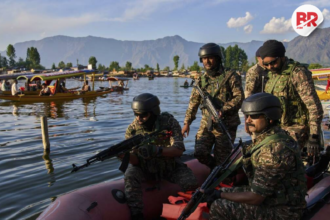
India has temporarily halted the flow of the Chenab River through the Baglihar Dam in Jammu and Kashmir.
The move comes just days after the deadly terror attack in Pahalgam, reigniting questions about India’s evolving strategy toward Pakistan—and the waters that bind them.

For the average Indian, this isn’t just about rivers or dams. It’s about action. For decades, India has shown restraint. But when terror flows in, can water still be expected to?
What’s Going On With the Chenab?
The Chenab River, flowing from Himachal Pradesh through Jammu and Kashmir into Pakistan, is one of the lifelines of the Indus River system. Its control, distribution, and flow are governed by the 1960 Indus Waters Treaty (IWT)—an agreement that has survived wars, conflicts, and diplomatic deadlocks.
But survival doesn’t mean immunity.
India’s move to temporarily block Chenab’s flow via Baglihar Dam might appear technical on the surface—routine maintenance, water level control, or power generation. Yet in the shadow of the Pahalgam terror attack, the symbolism is unmistakable.
When bullets fly across the border, it’s hard to believe water release is just business as usual.
The Baglihar Dam: More Than Concrete
The Baglihar Dam, a run-of-the-river hydroelectric project on the Chenab, has long irritated Pakistan. Islamabad has often alleged that the dam could allow India to hold back water—though India has adhered to IWT guidelines.
But here’s the irony: India never fully used its water rights under the treaty. Even while Pakistan-sponsored terror continued, India kept the taps open—literally.
This time, however, it looks like New Delhi is testing its full strategic toolkit. And water, it seems, is no longer off the table.
“You can’t shake hands with clenched fists—or expect water from clenched teeth.”
🚨 India has stanched the flow of water through the Baglihar Dam on the Chenab River and is planning similar measures at the Kishanganga Dam on the Jhelum River. (ET) pic.twitter.com/hqgIDeciap
— Indian Tech & Infra (@IndianTechGuide) May 4, 2025
Is India Weaponizing Water?
Technically? No.
Politically? That’s another story.
India has never abrogated the Indus Waters Treaty, nor has it violated its clauses. But the treaty gives India certain non-consumptive usage rights over rivers like the Chenab. Within those rights, India has every legal footing to manage water for power generation and flood control.
So is this a threat? Not overtly.
Is it a reminder? Absolutely.
Just like surgical strikes and border rebalancing, water diplomacy is now a card on the table—a tool, not a weapon.
For more background on the treaty, visit UN Water on Indus Waters Treaty.
What Could Happen Next?
This water maneuver could ripple across several fronts:
- Pakistan’s Agriculture: Heavily reliant on the Chenab for irrigation. A delay or disruption impacts its rabi crops.
- Diplomatic Heat: International observers may raise eyebrows, but the IWT legally protects India’s current moves.
- Public Sentiment in India: Many Indians support firmer actions post-terror attacks. Water diplomacy resonates with a public tired of restraint.
#WATCH | Jammu and Kashmir: Latest visuals from Reasi, where all gates of Salal Dam on Chenab River are closed. pic.twitter.com/rqaimJ0mq6
— ANI (@ANI) May 5, 2025
Why This Matters
India isn’t breaching the treaty—it’s asserting it. For decades, New Delhi has played by the rules while facing bloodshed on its soil. The Chenab pause is not about revenge. It’s about recalibrating respect.
When lives are lost in Kashmir, expecting water to flow unbothered into Pakistan is, frankly, a tone-deaf ask.
India’s message is simple: Peace unlocks water. Terror dams it up.
Looking Ahead
The ball—or rather, the dam gate—is now in Pakistan’s court. Will it rein in terror proxies and respect India’s red lines? Or will it continue provoking, expecting India to play nice while its people pay the price?
As for India, expect smarter strategies going forward. Diplomacy with edge, treaties with teeth, and yes—rivers that remember.
Also Read Baglihar Dam Shake-Up: India’s Water Flow Decision and What It Means for the Region












